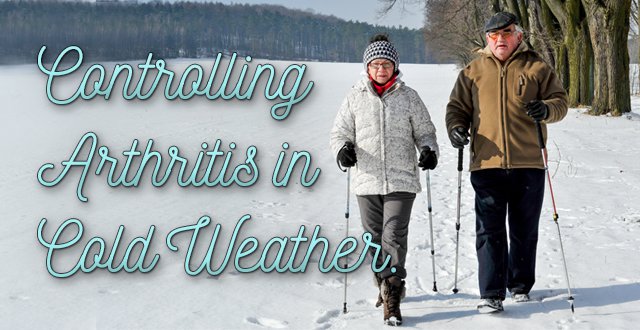Arthritis can give seniors a pretty hard time during the cold season. Symptoms like joint pain, swelling, joint stiffness and tiredness tend to worsen in the time of autumn and winter, both due to thermal discomfort and lack of physical activity.
But don’t worry! There are several easy ways you can manage these issues.
Complications of Arthritis During Cold Weather
Weather changes are often the cause that triggers arthritis flares. Very low temperatures rank as one of the leading phenomena that worsen the discomfort generated by joint inflammation. In these conditions, knowledge of effective methods to control the arthritis symptoms is essential.
Worsening Joint Pain
Although there is no scientific evidence to prove that the joint pain caused by arthritis worsens during the cold season, a large number of people complain about painful symptoms intensifying with exposure to ‘unfriendly’ temperatures.
One possible reason is that the freezing weather produces more muscle spasms which accentuate the pain that you normally feel in the joints. Also, the cold can reduce blood flow within the extremities, greatly amplifying discomfort. In this situation, it’s highly recommended to:
- Dress appropriately, using layered clothing. Use several layers of comfortable clothing, gloves and thick socks, in order to keep your internal temperature to a proper level.
- Use clothes that are easy to handle. Buttoned or zippered jackets are not a suitable choice, because they cause stiffness and pain in your fingers. Consider locking systems that are easier to handle or cover metal zippers with large pieces of fabric.
- Ask your doctor about light painkillers. Pain medication (non-steroidal and anti-inflammatory) may also help in controlling the joint pain.
Increased Predisposition to Colds and Flu
Arthritis is an autoimmune disease in which the body’s immune function attacks the joint tissue. This means that you are more vulnerable to get colds and flu during autumn and winter, because your immune system is already predisposed to inflammation and is no longer efficient in fighting against infections.
Moreover, the medications that treat arthritis suppress the immune system and increase predisposition to infection. Inflammation caused by arthritis also affects your lungs. But there are several ways to prevent this:
- Get vaccinated. The safest way to prevent flu and colds, especially in terms of vulnerability to the immune system, is get the influenza vaccination.
- Avoid contact with sick people. Insulate yourself as much as possible from people with flu and cold symptoms.
- Wash your hands often with soap and water. Contaminated hands are the most common way of bacteria and viruses transmission during the cold season.
Lack of Physical Activity
Movement is important in treating arthritis, as it relieves symptoms like joint stiffness and muscle weakness. In freezing weather, the alternatives to exercise are indeed limited, so here are some ways to keep your body moving:
- Take after-lunch walks. The days are shorter now and this is a major impediment to get involved in dynamic activities after lunch. But don’t hesitate to take advantage of your own house, apartment, yard or neighborhood and take a walk for about 15-20 minutes.
- Get Active indoors. Start exercising at home (you can use a senior exercising DVD) or slowly dance to your favorite music in the living room. Any form of exercise will help relieve the arthritis symptoms.
- Start each workout with a warm up. Take at least five minutes of stretching or walking in place before working out. This helps the blood circulate better into the joints.
- Stay properly hydrated. Hydration is as important in autumn and winter as in spring and summer, especially if you exercise.
Gaining Extra Weight
Another problem that worsens arthritis symptoms in the cold season is gaining extra weight, which has become a ’trend’ during this time of the year. Make a few healthy changes in your diet and lose the extra pounds. If every time you walk, your knees withstand a big pressure, dropping a pound or two will contribute to a better, less painful physiological state.
Vitamin D Deficiency
A limited sun exposure means less vitamin D production within your body. Vitamin D is an essential nutrient for calcium absorption into your bones. Being diagnosed with arthritis also makes you more prone to bone fracture. So, less calcium absorbed into your bones leads to an increased risk of bone fractures.
Avoid the vitamin deficiency by eating more foods high in vitamin D (fortified milk, fortified cereals, orange juice, yogurt, soy beverages and fatty fish). Also, ask your doctor about administering a vitamin D nutritional supplement, if necessary, to keep your arthritis symptoms under control during the cold weather.
Last but not least, enjoy this amazing time of the year! Cherish the wonderful holidays, maintain a peaceful state of mind and take good care of your health! Oh, and don’t forget to smile!
**Always consult your Doctor before beginning a new physical fitness routine!**

